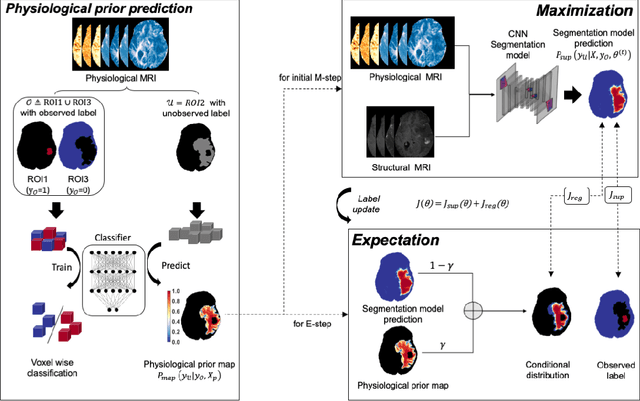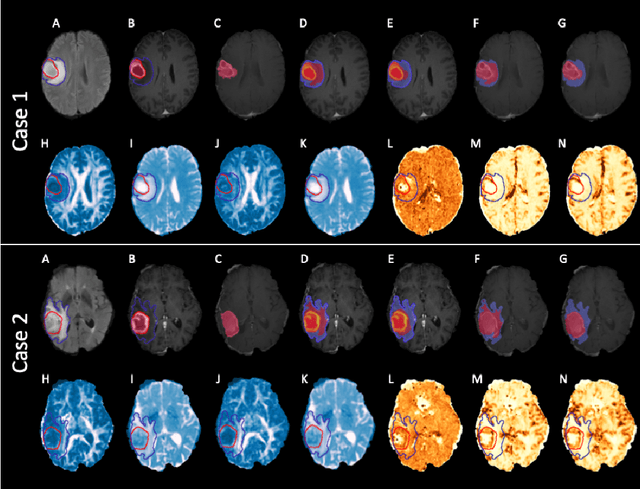Wenjian Huang
Mitigating Knowledge Discrepancies among Multiple Datasets for Task-agnostic Unified Face Alignment
Mar 28, 2025Abstract:Despite the similar structures of human faces, existing face alignment methods cannot learn unified knowledge from multiple datasets with different landmark annotations. The limited training samples in a single dataset commonly result in fragile robustness in this field. To mitigate knowledge discrepancies among different datasets and train a task-agnostic unified face alignment (TUFA) framework, this paper presents a strategy to unify knowledge from multiple datasets. Specifically, we calculate a mean face shape for each dataset. To explicitly align these mean shapes on an interpretable plane based on their semantics, each shape is then incorporated with a group of semantic alignment embeddings. The 2D coordinates of these aligned shapes can be viewed as the anchors of the plane. By encoding them into structure prompts and further regressing the corresponding facial landmarks using image features, a mapping from the plane to the target faces is finally established, which unifies the learning target of different datasets. Consequently, multiple datasets can be utilized to boost the generalization ability of the model. The successful mitigation of discrepancies also enhances the efficiency of knowledge transferring to a novel dataset, significantly boosts the performance of few-shot face alignment. Additionally, the interpretable plane endows TUFA with a task-agnostic characteristic, enabling it to locate landmarks unseen during training in a zero-shot manner. Extensive experiments are carried on seven benchmarks and the results demonstrate an impressive improvement in face alignment brought by knowledge discrepancies mitigation.
Continual Learning for Segment Anything Model Adaptation
Dec 09, 2024Abstract:Although the current different types of SAM adaptation methods have achieved promising performance for various downstream tasks, such as prompt-based ones and adapter-based ones, most of them belong to the one-step adaptation paradigm. In real-world scenarios, we are generally confronted with the dynamic scenario where the data comes in a streaming manner. Driven by the practical need, in this paper, we first propose a novel Continual SAM adaptation (CoSAM) benchmark with 8 different task domains and carefully analyze the limitations of the existing SAM one-step adaptation methods in the continual segmentation scenario. Then we propose a novel simple-yet-effective Mixture of Domain Adapters (MoDA) algorithm which utilizes the Global Feature Tokens (GFT) and Global Assistant Tokens (GAT) modules to help the SAM encoder extract well-separated features for different task domains, and then provide the accurate task-specific information for continual learning. Extensive experiments demonstrate that our proposed MoDA obviously surpasses the existing classic continual learning methods, as well as prompt-based and adapter-based approaches for continual segmentation. Moreover, after sequential learning on the CoSAM benchmark with diverse data distributions, our MoDA maintains highly competitive results in the natural image domain, approaching the zero-shot performance of the original SAM, demonstrating its superior capability in knowledge preservation. Notably, the proposed MoDA can be seamlessly integrated into various one-step adaptation methods of SAM, which can consistently bring obvious performance gains. Code is available at \url{https://github.com/yangjl1215/CoSAM}
Unsupervised Part Discovery via Dual Representation Alignment
Aug 15, 2024



Abstract:Object parts serve as crucial intermediate representations in various downstream tasks, but part-level representation learning still has not received as much attention as other vision tasks. Previous research has established that Vision Transformer can learn instance-level attention without labels, extracting high-quality instance-level representations for boosting downstream tasks. In this paper, we achieve unsupervised part-specific attention learning using a novel paradigm and further employ the part representations to improve part discovery performance. Specifically, paired images are generated from the same image with different geometric transformations, and multiple part representations are extracted from these paired images using a novel module, named PartFormer. These part representations from the paired images are then exchanged to improve geometric transformation invariance. Subsequently, the part representations are aligned with the feature map extracted by a feature map encoder, achieving high similarity with the pixel representations of the corresponding part regions and low similarity in irrelevant regions. Finally, the geometric and semantic constraints are applied to the part representations through the intermediate results in alignment for part-specific attention learning, encouraging the PartFormer to focus locally and the part representations to explicitly include the information of the corresponding parts. Moreover, the aligned part representations can further serve as a series of reliable detectors in the testing phase, predicting pixel masks for part discovery. Extensive experiments are carried out on four widely used datasets, and our results demonstrate that the proposed method achieves competitive performance and robustness due to its part-specific attention.
Cross Contrasting Feature Perturbation for Domain Generalization
Aug 16, 2023Abstract:Domain generalization (DG) aims to learn a robust model from source domains that generalize well on unseen target domains. Recent studies focus on generating novel domain samples or features to diversify distributions complementary to source domains. Yet, these approaches can hardly deal with the restriction that the samples synthesized from various domains can cause semantic distortion. In this paper, we propose an online one-stage Cross Contrasting Feature Perturbation (CCFP) framework to simulate domain shift by generating perturbed features in the latent space while regularizing the model prediction against domain shift. Different from the previous fixed synthesizing strategy, we design modules with learnable feature perturbations and semantic consistency constraints. In contrast to prior work, our method does not use any generative-based models or domain labels. We conduct extensive experiments on a standard DomainBed benchmark with a strict evaluation protocol for a fair comparison. Comprehensive experiments show that our method outperforms the previous state-of-the-art, and quantitative analyses illustrate that our approach can alleviate the domain shift problem in out-of-distribution (OOD) scenarios.
Strip-MLP: Efficient Token Interaction for Vision MLP
Jul 21, 2023Abstract:Token interaction operation is one of the core modules in MLP-based models to exchange and aggregate information between different spatial locations. However, the power of token interaction on the spatial dimension is highly dependent on the spatial resolution of the feature maps, which limits the model's expressive ability, especially in deep layers where the feature are down-sampled to a small spatial size. To address this issue, we present a novel method called \textbf{Strip-MLP} to enrich the token interaction power in three ways. Firstly, we introduce a new MLP paradigm called Strip MLP layer that allows the token to interact with other tokens in a cross-strip manner, enabling the tokens in a row (or column) to contribute to the information aggregations in adjacent but different strips of rows (or columns). Secondly, a \textbf{C}ascade \textbf{G}roup \textbf{S}trip \textbf{M}ixing \textbf{M}odule (CGSMM) is proposed to overcome the performance degradation caused by small spatial feature size. The module allows tokens to interact more effectively in the manners of within-patch and cross-patch, which is independent to the feature spatial size. Finally, based on the Strip MLP layer, we propose a novel \textbf{L}ocal \textbf{S}trip \textbf{M}ixing \textbf{M}odule (LSMM) to boost the token interaction power in the local region. Extensive experiments demonstrate that Strip-MLP significantly improves the performance of MLP-based models on small datasets and obtains comparable or even better results on ImageNet. In particular, Strip-MLP models achieve higher average Top-1 accuracy than existing MLP-based models by +2.44\% on Caltech-101 and +2.16\% on CIFAR-100. The source codes will be available at~\href{https://github.com/Med-Process/Strip_MLP{https://github.com/Med-Process/Strip\_MLP}.
Rethinking Alignment and Uniformity in Unsupervised Image Semantic Segmentation
Nov 26, 2022Abstract:Unsupervised image semantic segmentation(UISS) aims to match low-level visual features with semantic-level representations without outer supervision. In this paper, we address the critical properties from the view of feature alignments and feature uniformity for UISS models. We also make a comparison between UISS and image-wise representation learning. Based on the analysis, we argue that the existing MI-based methods in UISS suffer from representation collapse. By this, we proposed a robust network called Semantic Attention Network(SAN), in which a new module Semantic Attention(SEAT) is proposed to generate pixel-wise and semantic features dynamically. Experimental results on multiple semantic segmentation benchmarks show that our unsupervised segmentation framework specializes in catching semantic representations, which outperforms all the unpretrained and even several pretrained methods.
Sparse Local Patch Transformer for Robust Face Alignment and Landmarks Inherent Relation Learning
Mar 26, 2022



Abstract:Heatmap regression methods have dominated face alignment area in recent years while they ignore the inherent relation between different landmarks. In this paper, we propose a Sparse Local Patch Transformer (SLPT) for learning the inherent relation. The SLPT generates the representation of each single landmark from a local patch and aggregates them by an adaptive inherent relation based on the attention mechanism. The subpixel coordinate of each landmark is predicted independently based on the aggregated feature. Moreover, a coarse-to-fine framework is further introduced to incorporate with the SLPT, which enables the initial landmarks to gradually converge to the target facial landmarks using fine-grained features from dynamically resized local patches. Extensive experiments carried out on three popular benchmarks, including WFLW, 300W and COFW, demonstrate that the proposed method works at the state-of-the-art level with much less computational complexity by learning the inherent relation between facial landmarks. The code is available at the project website.
Expectation-Maximization Regularized Deep Learning for Weakly Supervised Tumor Segmentation for Glioblastoma
Jan 22, 2021



Abstract:We present an Expectation-Maximization (EM) Regularized Deep Learning (EMReDL) model for the weakly supervised tumor segmentation. The proposed framework was tailored to glioblastoma, a type of malignant tumor characterized by its diffuse infiltration into the surrounding brain tissue, which poses significant challenge to treatment target and tumor burden estimation based on conventional structural MRI. Although physiological MRI can provide more specific information regarding tumor infiltration, the relatively low resolution hinders a precise full annotation. This has motivated us to develop a weakly supervised deep learning solution that exploits the partial labelled tumor regions. EMReDL contains two components: a physiological prior prediction model and EM-regularized segmentation model. The physiological prior prediction model exploits the physiological MRI by training a classifier to generate a physiological prior map. This map was passed to the segmentation model for regularization using the EM algorithm. We evaluated the model on a glioblastoma dataset with the available pre-operative multiparametric MRI and recurrence MRI. EMReDL was shown to effectively segment the infiltrated tumor from the partially labelled region of potential infiltration. The segmented core and infiltrated tumor showed high consistency with the tumor burden labelled by experts. The performance comparison showed that EMReDL achieved higher accuracy than published state-of-the-art models. On MR spectroscopy, the segmented region showed more aggressive features than other partial labelled region. The proposed model can be generalized to other segmentation tasks with partial labels, with the CNN architecture flexible in the framework.
 Add to Chrome
Add to Chrome Add to Firefox
Add to Firefox Add to Edge
Add to Edge